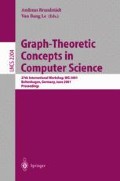Abstract
The Steiner problem is to find a shortest connection of a finite subset X in a given metric space (M, d). If the space meets some local compactness and connectivity conditions, then a solution, a Steiner minimal tree for X, exists [7]. More generally, considering any graph-theoretic tree T with all nodes of degree < 3 labeled by elements of X (that is, an X-labeled tree), we may ask for a minimal length realization of T in (M, d), that is, for an embedding of the node set of T in M which extends the identity map of X and yields the smallest possible length of the image Steiner tree (relative to the labeled tree T). The embedded unlabeled nodes of T are called Steiner points. A Steiner minimal tree is then that realization which attains minimum length among the (finite) collection of X-labeled trees. Given the subset X, one is interested in restricting the search for Steiner points in the metric space (M, d). Any proper subset of M that is guaranteed to harbor at least one Steiner minimal tree for X is called a Steiner hull for X 7,12. Particular interest attaches to Steiner hulls that are finitely generated in that they are determined by a finite subset S of M containing X and all Steiner points of some Steiner minimal tree for X; this finite set S can trivially be turned into a Steiner hull by attaching one geodesic from M for each pair of its points. For the Steiner problem in rectilinear space, that is, a d-dimensional real space equipped with the metric associated with the 1-norm, finitely generated Steiner hulls have been described 7,12.
Access this chapter
Tax calculation will be finalised at checkout
Purchases are for personal use only
Preview
Unable to display preview. Download preview PDF.
References
H.-J. Bandelt, P. Forster and A. Röhl, Median-joining networks for inferring intraspecific phylogenies, Mol. Biol. Evol. 16 (1999), 37–48.
H.-J. Bandelt, P. Forster, B.C. Sykes and M.B. Richards, Mitochondrial portraits of human populations using median networks, Genetics 141 (1995), 743–753.
H.-J. Bandelt and J. Hedlïková, Median algebras, Discrete Math. 45 (1983), 1–30.
H.-J. Bandelt, V. Macaulay and M.B. Richards, Median networks: speedy construction and greedy reduction, one simulation, and two case studies from human mtDNA, Molec. Phylogen. Evol. 16 (2000), 8–28.
H.-J. Bandelt and M. Van De Vel, Superextensions and the depth of median graphs, J. Combin. Theory Ser. A 57 (1991), 187–202.
G. Bergman, On the existence of subalgebras of direct products with prescribed d-fold projections, Algebra Universalis 7 (1977), 341–356.
D. Cieslik, Steiner minimal trees, Kluwer Acad. Publ., Dordrecht, 1998.
J. Farris, Methods for computing Wagner trees, Syst. Zool. 19 (1970), 83–92.
W.M. Fitch, Toward defining the course of evolution: minimal change for a specific tree topology, Syst. Zool. 20 (1971), 406–416.
D. Gusfield, Algorithms on strings, trees, and sequences: computer science and computational biology, Cambridge University Press, Cambridge, 1997.
J.A. Hartigan, Minimum mutation fits to a given tree, Biometrics 29 (1973), 53–65.
F.K. Hwang, D.S. Richards and P. Winter, The Steiner tree problem, North-Holland, Amsterdam, 1992.
D.L. Swofford, G.J. Olsen, P.J. Waddell and D.M. Hillis, Phylogenetic inference, In: Molecular systematics, Sinauer, Sunderland (D.M. Hillis, C. Moritz, and B.K. Marble, eds.), 1996.
M.L.J. Van De Vel, Theory of convex structures, North-Holland, Amsterdam, 1993
Author information
Authors and Affiliations
Editor information
Editors and Affiliations
Rights and permissions
Copyright information
© 2001 Springer-Verlag Berlin Heidelberg
About this paper
Cite this paper
Bandelt, HJ. (2001). Median Hulls as Steiner Hulls in Rectilinear and Molecular Sequence Spaces. In: Brandstädt, A., Le, V.B. (eds) Graph-Theoretic Concepts in Computer Science. WG 2001. Lecture Notes in Computer Science, vol 2204. Springer, Berlin, Heidelberg. https://doi.org/10.1007/3-540-45477-2_1
Download citation
DOI: https://doi.org/10.1007/3-540-45477-2_1
Published:
Publisher Name: Springer, Berlin, Heidelberg
Print ISBN: 978-3-540-42707-0
Online ISBN: 978-3-540-45477-9
eBook Packages: Springer Book Archive

